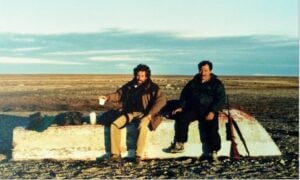It is Saturday September 13, 2014–the first quiet day that Louie Kamookak has enjoyed since Tuesday’s announcement that one of the lost ships of the Franklin Expedition had been found. We are spending the afternoon at his cabin, perched on a ridge between the sea and a shallow inland lake, just a few kilometers east of Gjoa Haven, Nunavut.
For everyone in Gjoa Haven, the find was a celebration. The entire community crowded together for a feast of char and dried caribou punctuated by traditional drumming, singing and dancing. Among the speakers was Kamookak, whose research into Inuit oral history influenced which areas Parks Canada chose to search for the ships.
When the typically eloquent Kamookak took the microphone to speak, he choked up. He’d been waiting for a moment like this since he was nine years, when the Canadian government plucked him from the land and enrolled him in the new school opened near the Gjoa Haven trading post.
Teachers at the school taught him of the Franklin Expedition – of explorers who had sailed from England feeling extensively prepared to spend years in the Arctic, but who were still overwhelmed by the severity of the conditions that they encountered.
“The stories the teachers told us matched the ones that my great-grandmother told me,” he says as we approach the two-room cabin he shares with his wife Josephine and youngest daughter Jade. “I could tell they were talking about the same people.”
Since the Franklin ship was found, news outlets from around the world have tried to pin him down for a quote or two about the role of Inuit traditional knowledge in the find. They haven’t had much success; Kamookak’s remote dwelling has no landline.
“They’ve been calling the school non-stop,” the high school teacher tells me. “I’ve had to apologize to everyone there for it. I’m the only Louie Kamookak in the world…just one, in the whole world. So people can find me. This might be easier if my name was Andrew Stewart. I’m just lucky that they can’t find my cell number. ”
Kamookak tells me that as the elders passed histories through generations, tales of one white explorer bled into the other. A story beginning with white men pulling a huge ship on a sled (likely referring to John Ross on the Boothia Peninsula) seamlessly becomes a tale of men scattering in different directions and dying (as Franklin’s men ultimately did, decades later.)
“The oral tradition tells a lot of history, but isn’t always very accurate,” Kamookak says.
Likewise, the journals we have from white explorers are frequently inexact. Language barriers with local Inuit led to explorers misunderstanding their location, but by considering both sides Kamookak is able to gather a relatively complete picture of historical events.
Sometimes, the oral history alone gives enough information to get a general idea, as is the case with the ship found in September 2014. The oral tradition placed one of Franklin’s ships in the Queen Maud Gulf. To the Inuit, it was known as Umertalit – the Big Boat Place.
Kamookak and I settle in for a cup of steaming tea boiled in a fire-charred kettle, and his wife Josephine kindly fries us some warm bannock. Between chews of the warm, sweet bread, we chat about the recent find, as well as what’s to come.
“There are so many archaeological sites in Nunavut. Not just from European explorers, but also from Inuit and Thule. There’s an island near here where you can find buttons that I think are from the Franklin Expedition and even a bone with some wool still sticking to it. I once found a shaman’s belt at a tent ring [on King William Island] that was decorated with a pair of scissors that match the ones that John Rae’s men used while they were here.”
When Kamookak makes such finds, he leaves them in place. He’s tried to convince government of Nunavut archaeologists to confirm some of these finds, but there’s a lot of archaeological work to be done in the territory and a limited window when it can be accomplished.
“I’d like to be able to take tourists there and show them,” Kamookak says, “but if I did that right now, anyone could look at me and think that I was just tricking them, that I’d just dropped the button there that day.”
Finding one of the ships is vindication for Inuit oral history, as well as Kamookak’s innovative approach to linking these histories with European ones, but his ultimate goal has never been finding the ships. It’s much more personal than that.
In the years after the explorer’s disappearance, Lady Jane Franklin – a wealthy aristocrat — funded several search parties that sought evidence of the fate of her husband and the expedition he led. Touched by her devotion, Kamookak is seeking to find Franklin’s final resting place, which he believes is somewhere near Cape Felix, on the west coast of King William Island.
Hunters in the area noticed a wooden cross set on a ridge, overlooking the water and visible from a distance. Could it be a signal of Franklin’s tomb intended for future searchers? If the explorer is buried there, it would help draw tourists to Nunavut, but more important to Kamookak, the lost explorer could finally return to his wife’s side.








